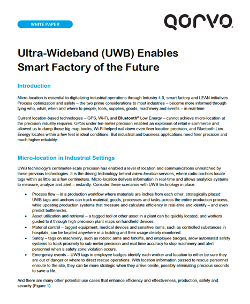Ultra-Wideband Case Study: UWB Delivers a Smoother Ride
April 19, 2024
When it comes to manufacturing, Ultra-Wideband (UWB) technology has emerged as a revolutionary tool that offers unparalleled precision in locating products and parts within a facility. While it may seem trivial to know the precise location of a product or part, the significance of this technology goes beyond simple inventory management. UWB is already transforming the future of manufacturing. Operators can optimize processes, enhance safety, and create a real-time digital model of their factories using UWB. These digital models provide a comprehensive understanding of who, what, when, and where in relation to people, tools, supplies, goods, machinery, and events. With real-time insights, operators can simply make more well-informed decisions.
Revolutionizing Location and Communication Capabilities
UWB technology offers unmatched accuracy in location and communication capabilities. UWB-powered micro-location services enable radio anchors to pinpoint tags precisely within a few centimeters. This level of accuracy provides real-time information so analytics systems can measure and analyze data so alerts can be sent instantaneously. The impact on manufacturing can be profound, with enhanced efficiency, improved asset tracking, and reduced downtime.
Establishing a New Normal
Traditional location-based technologies like GPS, Wi-Fi, and Bluetooth® Low Energy can fall short when it comes to meeting the modern, more stringent precision requirements of manufacturing. GPS may have revolutionized navigation, and Wi-Fi improved location accuracy, but the need for higher precision and reliability in industrial applications remains clear. UWB technology fills this gap, offering unparalleled signal integrity and ranging abilities.
Learn How UWB enables micro-location to transform factories so manufacturers can optimize processes and safety.
Unparalleled Coverage and Accuracy
UWB outshines other location and ranging technologies with its exceptional coverage and accuracy. By strategically placing anchors, objects can be precisely located in two- and three-dimensional space. With its ranging abilities, UWB covers greater distances, allowing tagged objects to be accurately tracked and positioned. This level of accuracy empowers operators to optimize workflows, reduce errors, and unlock new levels of operational efficiency.

UWB Case Study: SEG Automotive
SEG Automotive, a leading manufacturer of motors and starters for automotive giants worldwide, faced operational challenges due to manual processes and limited visibility of inventory. Seeking a solution, the company turned to a fully digital, real-time asset booking and tracking system. This shift required overcoming the challenge of accurately delivering materials to specific truck assembly process areas, necessitating a high level of precision. By deploying Sewio's UWB-based Real-Time Location System (RTLS), SEG Automotive achieved significant improvements in efficiency, accuracy and workforce allocation.
Enhanced Efficiency and Accuracy
Sewio's RTLS featured 40 anchors strategically placed across 2,000 square meters and 600 tags utilized to track metal pallets. By integrating this UWB-based system with existing data tracking and analysis systems, SEG Automotive experienced remarkable benefits, including the elimination of human picking errors and a 50 percent reduction in lead times. The company was also able to transition 15 percent of its employees from routine tasks to more value-added work. With continuous tracking and tracing capabilities, materials were closely monitored throughout the warehouse, ensuring seamless operations and efficient inventory management.
Overcoming Traditional Technology Limitations
Existing technologies like GPS, Wi-Fi, and Bluetooth Low Energy face limitations with large metallic objects like walls, vehicles, and machinery. GPS signals struggle to penetrate industrial structures, and Wi-Fi and Bluetooth Low Energy signals often run into interference that weakens their effectiveness. In light of this, UWB technology becomes a solution that not only overcomes these challenges but offers precise ranging and location capabilities.
UWB radios utilize a unique communication approach between anchors and tags, setting them apart from traditional narrow-band signals. Instead of relying on narrow-band signals, UWB radios transmit signals with low energy spread across a wide bandwidth. This approach provides several benefits, including faster pulse rise and fall times, ensuring superior signal quality while minimizing the impact of reflections and noise spikes. By leveraging UWB technology, SEG Automotive simplified its infrastructure requirements and achieved a robust and reliable tracking system.
Using a fully digital, real-time asset booking and tracking system empowered SEG Automotive to revolutionize its manufacturing operations. UWB-based RTLS helped the company eliminate errors, reduce lead times, and optimize workforce allocation. UWB technology also proved itself while confined to difficult industrial environments by performing through walls and other obstacles versus traditional technologies. As more industries embrace digital transformation, UWB technology will continue to offer unmatched precision and reliable tracking capabilities.
Learn more about UWB in this Qorvo White Paper: Ultra-Wideband (UWB) Enables Smart Factory of the Future.
Have another topic that you would like Qorvo experts to cover? Email your suggestions to the Qorvo Blog team and it could be featured in an upcoming post. Please include your contact information in the body of the email.
